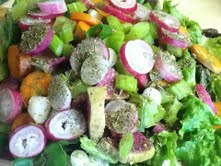The Mediterranean Diet is healthy, it’s true, but it’s not the only healthy way to eat. It just happens to be one that is heavily researched… and therefore marketed by the commodity boards representing foods that grow well in the Mediterranean. It so happens that California, the world’s eighth largest economy, and Chile, a country with a large agricultural tradition, have climates similar to the Mediterranean. Both economies depend on our love of the Mediterranean diet to thrive, and they therefore are a big part of the reason why so much research money has been invested into this way of eating.
I love the Mediterranean diet myself, but I sure don’t want anyone out there from other cultures abandoning their way of eating because it’s Northern European… or African… or Tasmanian. Mother Nature doesn’t play favorites—she makes sure she takes care of her Eskimos just as she nurtures her Italians. I thought it would be fun to survey varieties of cuisines around the world so that no matter what your origin, there’s something out there that is good for you.

I’ll start with German food, which is part of my personal heritage and what I was enjoying for lunch today. I made a salad with vegetables that likely would show up on a German summer salad, including two different types of radishes.

We got rutabagas and potatoes in our box this week, and I made the rutabaga-potato salad recipe our chef created. I had some lowfat chicken-apple bratwurst in the freezer, so thawed and cooked them up to have ready for the rest of the week’s lunches.

And… for dessert, I had some plain yogurt that I ground some Trader Joe’s coffee/chocolate/sugar mix on top of.
Let’s break that down for closer inspection.
Salad My salad had two different kinds of radishes, carrots, onions, celery, and a variety of lettuces. I sprinkled some German dill salad mix on top, then added apple cider vinegar and canola oil before tossing. Radishes: Great for cancer prevention. See my colleague Dr. Chris Wharton’s article on why radishes are so nutritious for more information. That beautiful red color? Comes from antioxidants similar to the ones blueberries get all the credit for. Onions: Very important to German cooking. And they are part of the __________family of vegetables, famous for __________________________-- Lettuce: I mixed several varieties to get more red color, again, to get more antioxidants.
Bratwurst The traditional version is a little bit fatty, but these days there are so many varieties chicken, turkey, and low-fat sausage, it’s easy to make a high-protein, low fat choice. This lunch, I had the green apple/cinnamon chicken variety from Fresh and Easy. Each link only had 110 calories.
Potatoes Potatoes? Yes, potatoes! How many of you stay away from them because you’ve been told they are high glycemic? Well, they are, if you don’t eat them wisely, such as eating them, super-sized, as French fries dripping in pro-inflammatory omega-6 oil.
The poor potato in this situation is not the culprit here, it’s the messenger. If you eat a small baked potato in a balanced meal, you’re doing ok. The potato salad I made has two benefits. Baked and then cooled potatoes contain resistant starch, a form of carbohydrate that is not immediately absorbed into your bloodstream. It passes into your large intestine where it ferments and becomes food for healthy bacteria (food that feeds those bacteria is also called prebiotic). Secondly, the dressing for this salad was vinegar. And as you’ve heard here many times before, vinegar helps to keep your blood sugar stable after meals, potentially as well as metformin. So a little bit of potato salad, without the mayo, holds potential to be PCOS-friendly.
Vinegar One of the strong points of the German diet is the vinegar. In addition to the salad, it’s used in pickled vegetables, sauerkraut, and sauerbraten. If it's sour, it's likely ok to eat!
Cheese Though I didn’t have any with this meal, cheese is something Germans love! A common breakfast is a piece of thinly sliced cheese on a slice of whole kernel rye bread, topped with a tomato. Cheese, remember, in moderation, has been found to be associated with increased fertility. The reason it works in the German diet is because, unlike Americans, Germans don’t shred, smother, and melt it on anything and everything they eat. It’s eaten in small portions and used to accent the rest of the food on the plate.
Berries Germany is pretty far north, meaning in the summer it is a fruit basket of flavor. Currants, strawberries, cherries, apples, peaches, grapes… you name it, someone is growing it. Mit sahne (with cream) is a popular way to serve fruit, and if it’s real cream and it’s minimally sweetened, it’s wonderful treat!
I have to tell you, the German meal I described above left me feeling so full and satisfied I wasn’t hungry until long after sundown. It really reinforced for me the power of eating balanced. Talk to people of German heritage, and they’ll often tell you about a grandparent or great-grandparent who lived, relatively disease-free, into their 90’s. They certainly didn’t get there on 800 calorie diets… perhaps we should be taking this diet a little more seriously instead of discounting it because of its potatoes.


